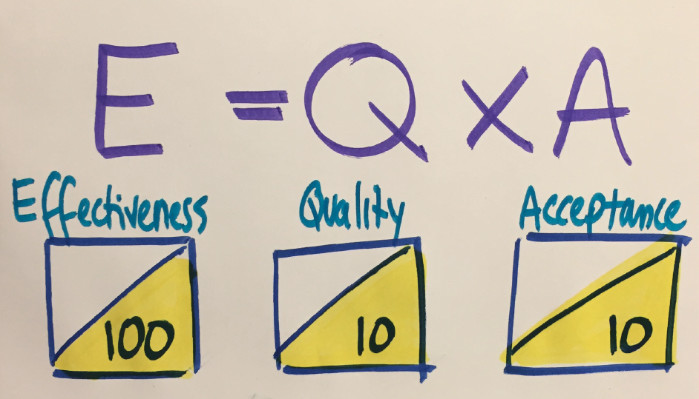
Where is your "E = Q x A?"
In this handy equation, E refers to "effectiveness;" Q stands for "quality;" and A stands for "acceptance."1
In the business world, the people I meet tend to understandably focus on Q, and from my perspective, neglect A, or at least not put as much effort into A as Q. Obtaining a high E can make the difference between success or failure. Most conversations center on quality, quality, quality... As important as quality is, when was the last time you held a conversation on the acceptance of an idea or presentation? Sometimes it just makes sense to ask a few people "how do you think this idea is going to land?" and then make changes accordingly.
E = Q x A is a simple equation, though there's nothing simplistic about it. In fact, if you run the numbers, something surprising happens (which happens to be true of any multiplication equation): increasing the smaller of the two variables results in a greater product than increasing the larger one. "Imagine Q=7 and A=3, giving you an overall effectiveness of 21," writes Rajeev Peshawaria[2]. "Most left-brained managers tend to continuously improve quality, and pay little attention to acceptance."
Watch what happens when you when you improve the quality of an idea while keeping acceptance low, versus improving acceptance while leaving quality alone. From 30 to 42, there is a 40% improvement. Imagine how you can use this in your presentations and everything else you do…
Increasing A with Q constant: you could also invest time and effort to raise acceptance from the initial 7 X 3 = 21 to a 7 X 10 of 70 -- landing a whopping 233% improvement. "The key point is simple," he says. "As a leader, you should ask yourself if you have succeeded in creating widespread acceptance. It is harder than most people think." What's required is selling the idea to a few key stakeholders, hearing their input, getting them onboard and or making needed adjustments to earn their acceptance.
How does this equation apply to your world, how you communicate, present and lead? I find it true not just in the business world, it also seems to be true when I pitch ideas to my family. Run the numbers for your projects from 1-10 on each variable. Start holding conversations on acceptance as well as quality. Your E depends on it!
Robbie Kahn www.rckomm.com
[1] Q x A = E - a formula advanced by Six Sigma writer George Eckes where A is a multiplier and should along with Q be assessed. Eckes suggests scoring each of Q and A out of 10, and that if E equals anything less than 60 ideas are unlikely to stick and projects are unlikely to succeed. The equation appears to be linked to GE and the Change Acceleration Program.
[2] “Too Many Bosses, Too few leaders”
Current Chief, Analytics and Evaluation @ Defense Health Agency | PhD, Six Sigma Master Black Belt
7yThe earliest peer reviewed journal article regarding e=q*a is Dr. Hoffman and Dr. Meier in 1965. Thank you for the post. Is there more historical significance regarding the formula?
Customer Service Team Lead at SPENN PH
8yA for attendance
Managing Director, Eiger Shipping SA,Geneva
8yWell written Robert-Kahn
| 🌎Worldwide Real Estate Consultant-REALTOR ®🌎 | Diverse Business Background | Intel® Supplier Quality Program Manager | Cross-Cultural Team Management | 🤝Community Advocate | Thunderbird | University of Vermont |
8yExcellent article; as I do tend to forget to "check in" as a high "D" in the Disc profile😍
R&D Scientist
8yE/A = Q ? or even better E/Q = A